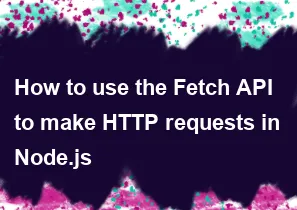How to use the Fetch API to make HTTP requests in Node.js

The Fetch API is commonly used for making HTTP requests in modern web browsers. However, in Node.js, the Fetch API is not natively available. To make HTTP requests in Node.js, you can use the node-fetch library, which brings the Fetch API to Node.js.
Here's a step-by-step guide on how to use the node-fetch library to make HTTP requests in Node.js:
Install
node-fetch:You need to install the
node-fetchlibrary using npm (Node Package Manager). Open your terminal or command prompt and run the following command:bashnpm install node-fetchUse
node-fetchin your code:Once you've installed
node-fetch, you can use it in your Node.js script. Here's a simple example:javascriptconst fetch = require('node-fetch'); // Replace the URL with the API endpoint you want to request const apiUrl = 'https://api.example.com/data'; // Basic GET request fetch(apiUrl) .then(response => { if (!response.ok) { throw new Error(`HTTP error! Status: ${response.status}`); } return response.json(); }) .then(data => { console.log('Data received:', data); }) .catch(error => { console.error('Fetch error:', error); });This example demonstrates a simple GET request. You can modify it based on your specific use case.
Handling POST requests:
If you need to make a POST request or include additional options like headers, you can pass a configuration object to
fetch:javascriptconst fetch = require('node-fetch'); const apiUrl = 'https://api.example.com/data'; const postData = { key1: 'value1', key2: 'value2', }; const requestOptions = { method: 'POST', headers: { 'Content-Type': 'application/json', // Add any additional headers as needed }, body: JSON.stringify(postData), }; fetch(apiUrl, requestOptions) .then(response => response.json()) .then(data => { console.log('Data received:', data); }) .catch(error => { console.error('Fetch error:', error); });This example shows how to make a POST request with JSON data.
That's it! With node-fetch, you can handle various HTTP methods and configure requests according to your needs. Remember to handle errors appropriately in your code.
-
Popular Post
- How to optimize for Google's About This Result feature for local businesses
- How to implement multi-language support in an Express.js application
- How to handle and optimize for changes in mobile search behavior
- How to handle CORS in a Node.js application
- How to use Vue.js with a UI framework (e.g., Vuetify, Element UI)
- How to configure Laravel Telescope for monitoring and profiling API requests
- How to create a command-line tool using the Commander.js library in Node.js
- How to implement code splitting in a React.js application
- How to use the AWS SDK for Node.js to interact with various AWS services
- How to use the Node.js Stream API for efficient data processing
- How to implement a cookie parser middleware in Node.js
- How to implement WebSockets for real-time communication in React
-
Latest Post
- How to implement a dynamic form with dynamic field styling based on user input in Next.js
- How to create a custom hook for handling user interactions with the browser's device motion in Next.js
- How to create a custom hook for handling user interactions with the browser's battery status in Next.js
- How to implement a dynamic form with dynamic field visibility based on user input in Next.js
- How to implement a dynamic form with real-time collaboration features in Next.js
- How to create a custom hook for handling user interactions with the browser's media devices in Next.js
- How to use the useSWRInfinite hook for paginating data with a custom loading indicator in Next.js
- How to create a custom hook for handling user interactions with the browser's network status in Next.js
- How to create a custom hook for handling user interactions with the browser's location in Next.js
- How to implement a dynamic form with multi-language support in Next.js
- How to create a custom hook for handling user interactions with the browser's ambient light sensor in Next.js
- How to use the useHover hook for creating interactive image zoom effects in Next.js